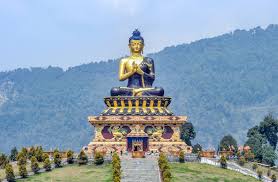
SIKKIM
Sikkim: A Complete Overview
Sikkim, a small state located in the northeastern part of India, is known for its stunning natural beauty, rich cultural heritage, and a blend of diverse ethnic groups. The state is bordered by Nepal to the west, Bhutan to the east, and China to the north. With a population of around 650,000 people, Sikkim is India's second-smallest state, both in terms of area and population. Despite its size, Sikkim is a highly significant state in terms of ecological diversity, tourism, and its unique status within the Indian Union.
Geography and Location
Sikkim lies in the eastern Himalayas, with the majestic Kanchenjunga, the third-highest peak in the world, towering over the state. The state’s topography is mostly mountainous, with a rich mix of forests, rivers, valleys, and meadows. Sikkim is the only state in India where the majority of the population practices Buddhism, and it is famous for its Buddhist monasteries. The state's geography also includes a variety of climatic zones, ranging from subtropical in the lower regions to alpine in the higher altitudes.
The state is blessed with diverse landscapes, from tropical forests and lush green valleys to snow-capped mountains. Major rivers like the Teesta and Rangit flow through Sikkim, contributing to its agricultural activities and scenic beauty. This topography also plays an essential role in the state's flora and fauna, making it a hotspot for biodiversity.
History and Political Structure
Sikkim was once an independent kingdom, known for its unique political and cultural identity. Historically, it was ruled by the Chogyals (monarchs) who were Buddhist and served as both political and spiritual leaders of the region. The Chogyal dynasty ruled Sikkim from the 17th century until the mid-20th century.
In 1975, after a referendum and significant political changes, Sikkim officially became the 22nd state of India. Prior to becoming a state, Sikkim was a protectorate of India, and its decision to join India was largely due to strategic and political reasons, especially the need for security given its location near international borders.
The state has a unicameral legislative assembly with 32 seats. The political structure includes the Chief Minister, who is the head of the state government, and a Governor, who represents the President of India in Sikkim.
Culture and Traditions
Sikkim is known for its cultural diversity, which is reflected in its various festivals, traditions, and languages. The population of Sikkim consists of three primary ethnic groups: Nepali, Bhutias, and Lepchas. These groups have their own distinct languages, traditions, and religious practices, but they live together in harmony.
Buddhism plays a significant role in Sikkim's culture, especially among the Bhutia people. Monasteries, such as the Rumtek Monastery and Tashiding Monastery, are major cultural and religious landmarks. The Lepcha people, on the other hand, have their roots in animism and nature worship, while the Nepali community is predominantly Hindu, and they celebrate festivals such as Dashain and Tihar with great zeal.
One of the most famous festivals celebrated in Sikkim is Losar, the Tibetan New Year, which marks the beginning of the new year according to the lunar calendar. It is a major event in Sikkim, celebrated with traditional dance, music, and rituals. Other significant festivals include Buddha Jayanti, Maghe Sankranti, and the Lohri festival, which is celebrated by the Nepali community.
The state also hosts several cultural events such as Sikkim Summer Festival and Sikkim Tourism Festival to showcase its art, handicrafts, and dance forms, making Sikkim a popular destination for travelers.
Economy and Infrastructure
The economy of Sikkim is primarily agrarian, with agriculture and horticulture being the mainstay for a significant portion of the population. The state grows crops like rice, maize, barley, and vegetables, and is particularly famous for its production of cardamom, which is one of the highest earners in the state. Additionally, tea plantations are also prevalent in Sikkim, especially in the southern part of the state. Sikkim's agricultural sector has benefited from the state's commitment to organic farming, as Sikkim became the first state in India to declare itself completely organic in 2016.
Sikkim is also focusing on developing its tourism industry, leveraging its natural beauty, adventure activities, and cultural heritage. The state's tourism sector attracts a growing number of visitors each year, particularly for trekking, mountaineering, and nature walks. Popular tourist destinations include Nathula Pass, Zuluk, Yuksom, and Pelling. The state's pristine environment, snow-capped peaks, lakes, and forests are a major draw for both domestic and international tourists.
Sikkim has made significant progress in infrastructure development in recent years. The state is well-connected by road, and Gangtok, the capital city, serves as the main center for administrative and commercial activities. Sikkim is also working on improving its road and rail networks to boost tourism and trade with neighboring countries. The development of Sikkim Airport at Pakyong, which opened in 2018, has improved connectivity and made the state more accessible to visitors.
Education and Healthcare
Sikkim has made considerable progress in the field of education and healthcare. The state government has set up numerous schools, colleges, and universities to improve literacy and offer higher education. Sikkim University, located in Gangtok, offers various undergraduate and postgraduate programs. Many students from Sikkim also pursue higher education in other parts of India, particularly in Kolkata and Delhi.
In terms of healthcare, the state government has focused on providing better access to medical services, with hospitals, primary healthcare centers, and dispensaries being set up across the state. Sikkim is working toward improving its healthcare infrastructure to ensure that even remote areas receive medical attention.
Environment and Conservation
Sikkim is renowned for its biodiversity and conservation efforts. The state's commitment to organic farming has played a vital role in preserving its environment, and Sikkim is known for its clean and green initiatives. The state has several national parks and wildlife sanctuaries, including the Khangchendzonga National Park, which is a UNESCO World Heritage site. This park is home to a rich variety of flora and fauna, including endangered species like the red panda.
Sikkim is also known for its conservation of wildlife and forests, and it continues to make strides in preserving its natural resources. The government has implemented policies to protect its environment, combat deforestation, and promote eco-tourism.
Conclusion
Sikkim, despite being small in terms of size and population, is a state with a rich cultural heritage, stunning landscapes, and a strong commitment to environmental conservation. The state's people, policies, and government work toward maintaining its natural beauty while fostering development in sectors such as agriculture, tourism, and education. With its focus on organic farming, sustainable development, and tourism, Sikkim continues to be a model for other states in India, demonstrating that even small regions can have a significant impact on the nation’s development.
